HOW TO CHOOSE AN AIR PUMP FOR YOUR POND?
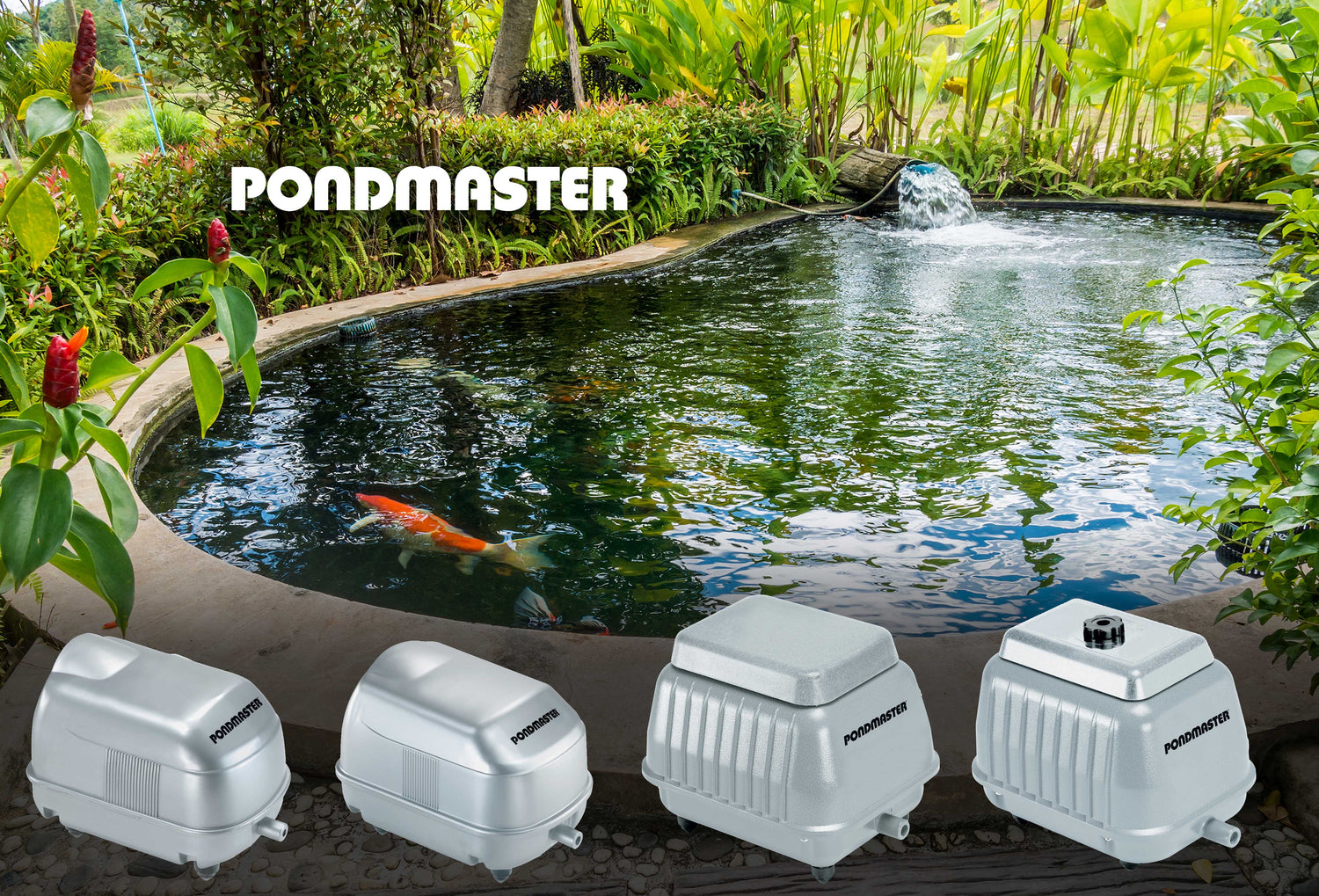
Adequate aeration is crucial for maintaining a healthy and thriving aquatic ecosystem in your pond. An air pump can help provide oxygen to fish and other aquatic creatures in your pond. This article will discuss the essential factors to consider when selecting an air pump for your pond to help you make an informed decision that best suits your pond's needs.
-
Size of the pond:
The size of the pond is an essential factor to consider when selecting an air pump. You need to choose a pump that can provide enough oxygen to the entire pond.
-
Depth of the pond:
The depth of the pond is another important consideration when selecting an air pump. You need to ensure that the pump you choose can deliver air to the bottom of the pond to provide oxygen to the fish and other aquatic creatures.
-
Number of fish:
The number of fish in your pond can also affect the choice of an air pump. More fish in a pond means more oxygen demand. Therefore, you need to choose a pump that can provide enough oxygen for all the fish in the pond.
-
Noise level:
The noise level of an air pump can be a concern for some pond owners. If you plan to install an air pump near your home, you may want to choose a pump that operates quietly.
-
Energy efficiency:
An energy-efficient air pump can save you money in the long run. Consider choosing a pump with a low wattage but can still provide enough oxygen to the pond.
-
Durability:
You want an air pump that can withstand the elements and last long. Consider choosing a pump made of high-quality materials that can resist corrosion and rust.
-
Type of air pump: Different types of air pumps are
available in the market. Some popular options include diaphragm pumps, piston pumps, and linear air pumps. Consider choosing the type of pump that best suits your pond's needs.
Pondmaster AP-Series Air Pumps |
Air Output Volume |
Watts |
Outlets |
Pressure (PSI) |
Depth (Feet) |
|---|---|---|---|---|---|
|
AP-20
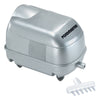
|
1700 cu.in/min | 20 | 6 | 4.0 | 9.2 |
|
AP-40
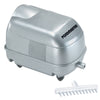
|
2900 cu.in/min | 40 | 12 | 4.85 | 11.2 |
|
AP-60
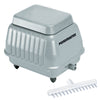
|
5500 cu.in/min | 60 | 14 | 5.66 | 13.1 |
|
AP-100
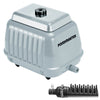
|
9150 cu.in/min | 100 | 33 | 6.53 | 15.1 |
Understanding Pond Aeration Basics
Before choosing an air pump for your pond, it's essential to understand the basics of pond aeration. Here are some key points to consider:
-
Oxygen demand:
Fish and other aquatic creatures in your pond require oxygen to survive. As the water temperature increases, the oxygen demand also increases. Without adequate aeration, the water can become stagnant, leading to low oxygen levels that can harm or even kill the fish.
-
Beneficial bacteria:
Beneficial bacteria in your pond break down organic matter, such as fish waste and decaying plant matter. However, these bacteria also require oxygen to carry out their function. Without enough oxygen, the bacteria population can decline, affecting the pond's overall health.
-
Algae growth:
Algae growth is a common problem in ponds, especially in summer. Algae can compete with fish for oxygen, leading to low oxygen levels in the pond. Proper aeration can help prevent algae growth by providing enough oxygen to the fish and other aquatic creatures, limiting the nutrients available for the algae.
-
Water circulation:
Aeration can also improve water circulation in your pond. The air pump releases bubbles into the water, creating a current that moves the water around. This movement can help prevent stagnant areas in the pond and distribute oxygen and nutrients throughout.
-
Seasonal changes:
The oxygen demand in your pond can vary depending on the season. During the summer, when the water temperature is higher, oxygen demand increases. In the winter, the water temperature drops, and the oxygen demand decreases.
By understanding these basics of pond aeration, you can choose an air pump that meets your pond's specific needs. Aeration is a crucial aspect of pond maintenance, and a properly aerated pond can provide a healthy and thriving environment for fish and other aquatic creatures.
Assessing Your Pond's Size and Depth
Assessing the size and depth of your pond is a critical step in choosing the right air pump. Here's what you need to know:
-
Measuring the pond:
Before choosing an air pump, you need to measure the dimensions of your pond. Measure the pond's length, width, and depth to determine the total volume of water. You can then use this information to choose an air pump that can provide enough oxygen to the entire pond.
-
Calculating the pond volume:
To calculate the pond's volume, use the formula: Length x Width x Depth x 7.5 = Gallons. For example, if your pond is 10 feet long, 8 feet wide, and 4 feet deep, the volume would be 10 x 8 x 4 x 7.5 = 2,400 gallons.
-
Oxygen requirements:
The oxygen requirements for your pond will depend on the total volume of water. As a general rule, you want an air pump that can move the entire volume of water in the pond at least once every two hours. This ensures that all areas of the pond receive enough oxygen.
-
Deep ponds:
If your pond is deep, you may need a stronger air pump to ensure enough oxygen reaches the bottom of the pond. Consider choosing an air pump that can deliver air to the bottom of the pond, even if it's deep.
-
Shallow ponds:
Shallow ponds may not require as much aeration as deeper ponds. However, you still need to choose an air pump that can provide enough oxygen to the entire pond.
Determining Pond Oxygen Demand
Understanding your pond's oxygen demand is crucial when choosing an air pump. Here are some factors to consider:
-
Fish population:
The number of fish in your pond affects the oxygen demand. More fish means a higher oxygen demand.
-
Other aquatic creatures:
Fish are not the only creatures in your pond that require oxygen. Other aquatic creatures like snails and turtles also need oxygen to survive. Consider the total population of all aquatic creatures in your pond when determining the oxygen demand.
-
Temperature:
The water temperature in your pond affects the oxygen demand. As the water temperature increases, the oxygen demand also increases. During hot summer, your pond may require more aeration to meet the increased oxygen demand.
-
Organic matter:
Organic matter in your pond, such as decaying plant matter and fish waste, also affects the oxygen demand. Beneficial bacteria that break down organic matter require oxygen to carry out their function. If there is an excess of organic matter, the oxygen demand can increase, requiring more aeration.
-
Water quality:
Poor water quality can lead to low oxygen levels in your pond. If your pond has high levels of nutrients or algae, the oxygen demand can increase. Proper aeration can help prevent algae growth and improve water quality.
Types of Pond Air Pumps: Diaphragm, Piston, and Linear
There are several types of air pumps available for pond aeration. Here are the three most common types:
-
Diaphragm air pumps:
These pumps use a flexible rubber diaphragm to compress the air and pump it into the pond. They are quiet and energy-efficient but may not be suitable for deeper ponds or those with high oxygen demand.
-
Piston air pumps:
Piston pumps use a piston to compress the air and pump it into the pond. They are suitable for deeper ponds and those with high oxygen demand but tend to be louder and less energy-efficient than diaphragm pumps.
-
Linear air pumps:
: Linear air pumps use a linear motor to vibrate a diaphragm and pump air into the pond. They are suitable for ponds with a high oxygen demand and are typically the most energy-efficient type of air pump. However, they can be louder than diaphragm pumps.
Key Features to Consider in a Pond Air Pump
When choosing an air pump for your pond, here are some key features to consider:
Pump output: The pump's output should match your pond's oxygen demand. Consider the pond size, depth, fish population, and other aquatic creatures when selecting the pump output.
Cord length: Ensure the pump's cord length is sufficient to reach the power source and pond.
Weather resistance: The pump should be weather-resistant to withstand outdoor elements.
Warranty: Look for a pump with a warranty to ensure you can get it replaced or repaired if necessary.
Serviceability: Diaphragm pumps can usually be repaired if a diaphragm wears out. This can be a better alternative than changing the entire pump.
Brand reputation: Choose a pump from a reputable brand with a record of producing high-quality pond equipment.
Pond Air Pump Energy Efficiency and Noise Levels
Here are some additional factors to consider when selecting an air pump for your pond:
Energy efficiency: Choose an air pump with low wattage to save money on energy costs.
Noise level: Some air pumps can be noisy, which may concern some pond owners. Look for pumps with noise-reduction features, such as rubber feet or mufflers.
Installation and Maintenance Tips
Once you've selected the right air pump for your pond, here are some tips for installation and maintenance:
Choose a location for the air pump sheltered from the elements and secure enough to prevent the pump from falling into the pond.
Use a check valve to prevent water from flowing back into the pump
Clean or replace the air stones regularly to prevent blockages and maintain optimal oxygen flow.
Check the pump regularly for signs of wear or damage and replace any damaged parts immediately.
Follow the manufacturer's recommended maintenance schedule to ensure the pump functions properly.
If pump has an intake filter remove it and clean it periodically.
Safety Precautions for Air Pump Operation
When operating an air pump for your pond, there are some safety precautions to keep in mind:
Keep the pump away from water: Ensure that the pump is situated in a dry location away from the pond to prevent electric shock.
Use a ground fault circuit interrupter (GFCI): A GFCI is a safety device to help prevent electrical shock. Plug the air pump into a GFCI-protected outlet to ensure safety.
Use a weatherproof cover: Use a weatherproof cover for the electrical outlet to protect against moisture and reduce the risk of electrical shock.
Matching the Air Pump with Proper Aeration Accessories
To optimize the performance of your air pump, consider using additional aeration accessories, such as air stones and diffusers. Here are some factors to consider:
Air stones: Air stones help diffuse air into the water, creating more bubbles and improving oxygenation. Choose air stones that matches the air pump's output.
Air diffusers: Air diffusers create finer bubbles, which increases the oxygen exchange rate. They are suitable for ponds with high oxygen demand.
Airline tubing: Choose high-quality airline tubing to ensure the air pump delivers air to the air stones and diffusers efficiently.
Check valves: These help prevent water from flowing back into the air pump and causing damage.
Frequently Asked Questions about Pond Air Pumps
Here are some commonly asked questions about pond air pumps:
How long should I run the air pump? You should run the air pump continuously to ensure the pond receives enough oxygen.
Can I use multiple air pumps in one pond? Yes, you can use multiple air pumps to aerate a large pond or provide more oxygen to specific pond areas.
How loud are air pumps? The noise level of air pumps varies depending on the type and model. Look for air pumps with noise-reduction features, such as rubber feet or mufflers.
How do I maintain my air pump? Regularly clean the air stones or diffusers to prevent blockages and check the pump for signs of wear or damage. Periodically check air lines from the pump to see that they have not collapsed or gotten kinked. Follow the manufacturer's recommended maintenance schedule.


